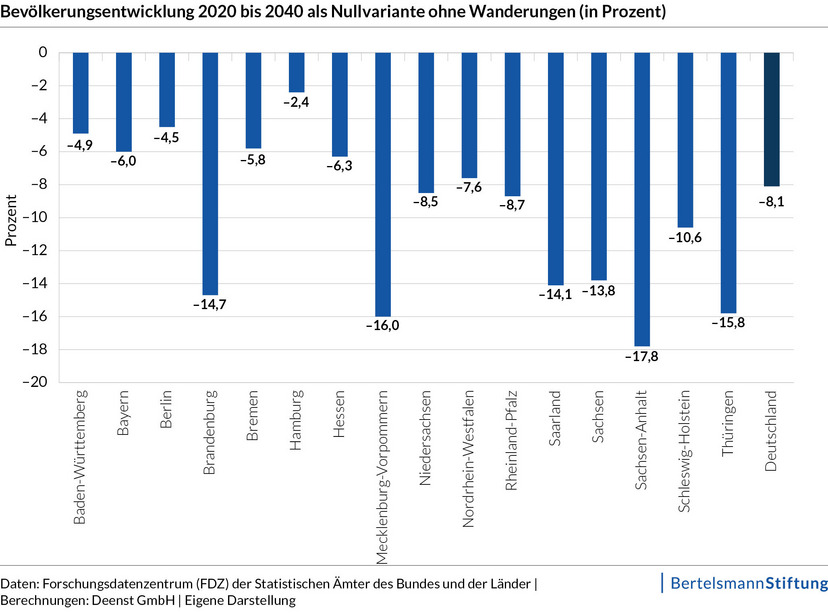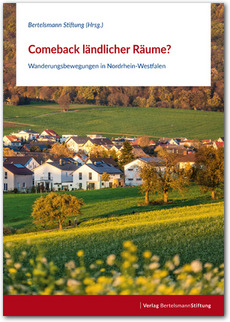Germany’s demographic development is not only dependent on birth and death rates. Migration – i.e. people moving in or out of the country (external migration) or within the country (internal migration) – is a decisive factor. This is shown by the “zero variant,” a theoretical scenario in which population development is considered only from the perspective of births, deaths and age structure. One forecast based on this scenario reveals that, without migration, Germany’s population would shrink by over 8 percent by 2040. In individual states such as Saxony-Anhalt, the figure would be almost 18 percent.
![[Translate to English:] Bevölkerung](/fileadmin/files/_processed_/9/6/csm_AdobeStock_68946689_KONZERN_ST-CC_01_74200913de.jpg)
© Jürgen Fälchle - stock.adobe.com
Migration as a driver of demographic development
Migration is playing a key role in population developments in Germany. The Bertelsmann Stiftung’s latest analysis shows that the population would shrink significantly without immigration. Rural areas in particular are gaining in importance due to new migration trends – caused not least by the Covid-19 pandemic.
Content
Migration determines growth or decline
This means immigration not only compensates for the decline that results where there are more deaths than births, it can also lead to a population increase. This became evident in 2015 and 2016 when many refugees arrived in Germany, particularly from Syria, Iraq and Afghanistan, and in 2022, when they came from Ukraine.
External migration: more people, new patterns
The number of people moving to Germany has increased significantly over the last 30 years – especially since 2010. Not only are more people coming to the country, their backgrounds have also changed: Immigrants today are more commonly families with children, or older people. The traditional image of young, single immigrants coming to work is now only part of the picture.
Moreover, the new arrivals are more evenly distributed across Germany’s states. There used to be major differences. Today, almost all of the country’s regions benefit from immigration, especially the major cities, which have the highest “net migration rates” (the difference between people moving in and moving out per 1,000 inhabitants).
Economic migration is only one part of external migration. Education migration, family migration, refugee migration exhibit different patterns and have an impact on the age structure and regional distribution across communities.
Petra Klug, Senior Project Manager, Bertelsmann Stiftung
Internal migration: Stable, but with potential for change
Compared to external migration, migration within Germany is less dynamic. Young people between the ages of 20 and 30 often change their place of residence – usually due to education, training or employment. This age group is the main driver of internal migration.
One striking trend: While Germans are moving less frequently across state lines, people with non-German citizenship are becoming more mobile. Overall, the level of internal migration has remained constant – although the demographics of the people who are moving are changing.
North Rhine–Westphalia: Rural areas are catching up
The analysis also focuses on the state of North Rhine–Westphalia. It is particularly clear that many rural areas there have become more attractive in recent years. Counties like Euskirchen and Steinfurt, for example, have exhibited significant net inflows of residents.
One driver of this trend was the Covid-19 pandemic. In addition to tight housing markets and higher living costs, particularly in city centers, the extraordinary situation during the pandemic caused many people to rethink how they want to live. The desire for more space and more nature and the possibility of working from home made life outside of major cities seem more attractive. Although big cities remain popular, the number of people moving to surrounding communities or rural areas continues to grow.
Population policies require robust data
The findings show that migration – whether within or from outside Germany – is a key factor in demographic development. Without immigration, many municipalities would shrink. Rural regions in particular could benefit if they positioned themselves as attractive places to live.
Such analyses are indispensable for policy makers and public administrators. They make it possible to plan infrastructure, housing and social services – based on realistic forecasts and specific regional developments. Various indicators on population developments in all of Germany’s municipalities with at least 5,000 inhabitants are available as historical data and forecasts in our Wegweiser Kommune (Community Roadmap) portal – making it a valuable tool for analysis and planning.


![[Translate to English:] Wegweiser Kommune](/fileadmin/files/_processed_/f/6/csm_iStock-1227452502_MPL_AdobeStock_353971897_KONZERN_Key_Visual_04_6f8bfa831a.jpg)
![[Translate to English:] Wegweiser Kommune](/fileadmin/files/_processed_/0/c/csm_Fotolia_98926123_X-Duplex_ST-LK_4a3804c7b1.jpg)
![[Translate to English:] Bevölkerung](/fileadmin/files/_processed_/9/a/csm_AdobeStock_68946689_KONZERN_ST-CC_02_ab8f69dd70.jpg)

![[Translate to English:] Landschaft](/fileadmin/files/_processed_/9/0/csm_AdobeStock_252046738_KONZERN_ST-CC_bearb_Original_96691_abf5b7c75d.jpg)
![[Translate to English:] Ein Landwirt steht in einem Feld und hält ein Tablet in der Hand](/fileadmin/files/_processed_/4/b/csm_AdobeStock_274990218_KONZERN_ST-LK_Original_97477_c1986149e9.jpeg)



